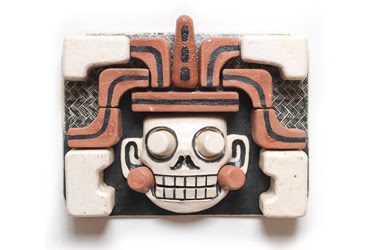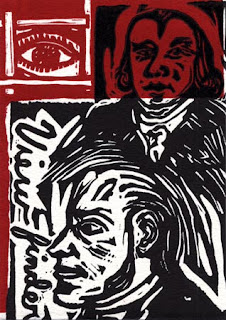(To learn more about the “Viewfinder Project” see the original post.)
Rarely do most of us scrutinize a person’s features beyond passing glances much less get a good look at a person unclothed. An essential aspect of drawing the figure from life is an intense study of form. Figure drawing is challenging in part because of judgements about proportions and shape. If the draftsman’s observations are off, then the rendering will look less like the model. Figure drawing is also one of the few opportunities to see the human body in an unobscured or unmediated way. After one draws from the figure it becomes easier to imagine or invent figures based on this study.
 |
| Heyd Fontenot’s “Viewfinder”, Paul Sitting On His Feet, 6 by 4 1/4 inches, Ink, 2006 |
Heyd Fontenot and Brian Jermusyk present a view of life unclothed. However, their work transcends mere study. Both artists offer a commentary on the way we live and the way we choose to see ourselves. They also use a comic style that mixes seriousness with humor. Fontenot will often draw and paint the unclothed figure coupled with animal counterparts. He also emphasizes the relationship between facial expressions and pose revealing a range of raw emotions such as surprise, boredom, disgust, and ecstasy. In the image Hyde sent to me (seen above) the figure appears to turn his head to the viewer, with a coy knowing look, while shifting the body to emphasize his back. Like old Hollywood movies there is mystery; we think we know what is there but we can not see everything.
 |
| Brian Jermusyk,”Viewfinder”, 4 1/4 by 6 inches, Graphite, 2006 |
Brian Jermusyk has worked on a series called The “T” Drawings which are informed and influenced by reading the published diaries of Kenneth Tynan. Jermusyk presents a complex view of the sexual being. Sex brings pleasure but attached are inevitable psychological and at times physical costs. Many of these drawings depict a seductive cycle of birth, life, and death all in the same image. When Jermusyk places these stages in close proximity a mixture of pain, pleasure, and anxiety feel palpable.
The drawing seen above seems to be a beginning piece to a narrative. This drawing appears to depict the curiosity found in recognizing another’s form as sensual. Given connections both in terms of subject and approach to other drawings included in the “T” series, the assumed result of this encounter point toward a scene of a birth amidst a specter of death. Although the idea of death can not be separated from birth, the latter drawings mentioned serves as a reminder of how dangerous birthing has been (and still is in certain parts of the world) to both mother and child.









